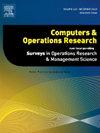考虑工人熟练程度差异的双资源柔性作业车间调度
IF 4.3
2区 工程技术
Q2 COMPUTER SCIENCE, INTERDISCIPLINARY APPLICATIONS
引用次数: 0
摘要
目前,由于生产车间内所有年龄组工人的显著分布以及他们操作机器熟练程度的差异,越来越多地注意到生产系统中的资源限制。提高工人的熟练程度需要时间和知识。随着劳动力退休年龄的推迟,老年工人工作时间的延长可以帮助他们获得更多的经验。随着经验积累的提高,加工前的机器调试、检查、清洗等必要的准备工序等与人有关的工作时间将大大减少。在做出生产决策时,考虑到这些因素是至关重要的,需要调整工作分配以适应个体工人的能力。通过这种方式,可以将工业5.0所倡导的“以人为本制造”的经济指标与车间生产相结合。在此场景中,考虑到工人技能水平的差异和基于此变化的过程设置时间,以最小化双资源柔性作业车间调度问题(DRCFJSP)的设置时间和处理时间之和为目标,构建了一个数学模型。该模型还考虑了工人的技能和熟练程度。针对该问题的特点,采用候鸟优化算法(MBO)进行求解。最后,在仿真算例上进行了对比实验。实验结果证明,在调度模型中考虑不同熟练程度工人对准备时间的影响,可以显著优化生产总完成时间。本文章由计算机程序翻译,如有差异,请以英文原文为准。
Dual-resource flexible job shop scheduling considering worker proficiency differences
Currently, the increasing attention to resource constraints in production systems is driven by the notable distribution of workers across all age groups within the production shop and the discrepancy of their proficiency in operating machines. It takes time and knowledge to improve workers’ proficiency. And as the workforce retires later, the longer working hours of older workers can help them gain more experience. With the improvement of accumulated experience, the time spent on human-related tasks such as machine debugging, checking, cleaning, and other necessary preparation processes before processing will be significantly reduced. Considering these factors is crucial when making production decisions, necessitating the adaptation of job assignments to suit the capabilities of individual workers. Through this approach, the economic indicators of ‘people-oriented manufacturing’ advocated by Industry 5.0 and workshop production can be jointly realized. In this scenario, a mathematical model is constructed with the objective of minimizing the sum of setup time and processing time for the double-resource flexible job shop scheduling problem (DRCFJSP), considering the differences in worker skill levels and varying process setup times based on this. The model takes the skills and proficiency of workers into consideration as well. Given the problem’s characteristics, the migratory bird optimization algorithm (MBO) is applied to address this issue. Finally, a comparative experiment is carried out on a simulation example. The experimental results verify that incorporating the influence of workers with different proficiency on preparation time into the scheduling model can significantly optimize the total production completion time.
求助全文
通过发布文献求助,成功后即可免费获取论文全文。
去求助
来源期刊

Computers & Operations Research
工程技术-工程:工业
CiteScore
8.60
自引率
8.70%
发文量
292
审稿时长
8.5 months
期刊介绍:
Operations research and computers meet in a large number of scientific fields, many of which are of vital current concern to our troubled society. These include, among others, ecology, transportation, safety, reliability, urban planning, economics, inventory control, investment strategy and logistics (including reverse logistics). Computers & Operations Research provides an international forum for the application of computers and operations research techniques to problems in these and related fields.
 求助内容:
求助内容: 应助结果提醒方式:
应助结果提醒方式:


